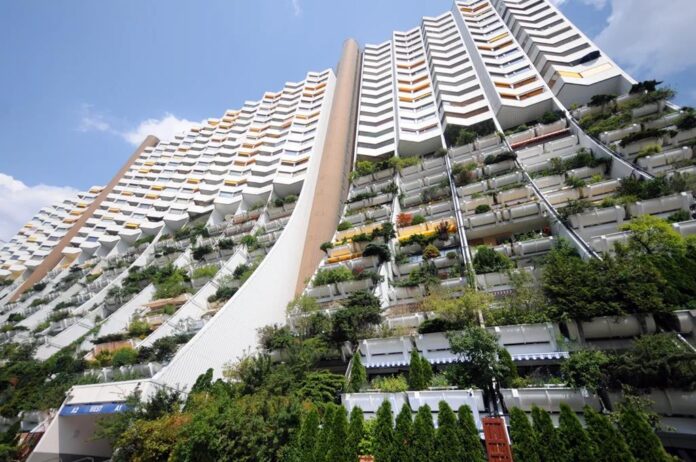Things were not looking good. The city — the entire country, really — was in the midst of a housing crisis. The government struggled to rehome people who preferred their marginal, community-centered lifestyle to the shelters the city had provided. On top of that, the subject of immigration was leading to increased racial tensions. When a fire broke out in a squatter settlement in which four people lost their lives, the government resolved to act — swiftly.
If this sounds familiar, it should, because very few of our problems are ever entirely novel, and you’d be forgiven for assuming that the fire in question had erupted in a tent city in Vancouver or Toronto. However, the fire actually broke out in May of 1961 — in Singapore. The blaze was devastating, leaving roughly 16,000 instantly homeless. The story, however, is ultimately one of success, because the tiny island nation rehomed everyone within a year.
So how did Singapore do it?
It helped that the country was already in the housing business, with a pre-existing stock of apartments. The year before that deadly inferno razed the squatter settlement of Bukit Ho Swee, the Singaporean government had established the Housing & Development Board (HDB), tasked with building public housing. After the fire, the HDB so quickly and successfully housed the displaced population that it gained a remarkable reputation. Their operation quickly scaled and cemented public housing as a viable and attractive option for many residents. Now, roughly 80 per cent of Singapore’s population live in public housing that is designed and built by the HDB, and these homes exist in expansive planned communities in one of the globe’s most sustainable cities.
It’s difficult to say how a Canadian city would respond if, say, a sold-out crowd at the Pacific Coliseum lost their houses overnight, but given that Greater Vancouver’s 2023 Homeless Count identified 4,821 individuals experiencing homelessness (a 32 per cent increase from 2020), it seems unlikely that it would accomplish much. Canada’s housing crisis shows no signs of abating, and the provincial government has rolled out new restrictions in an attempt to alleviate the strain. In recent years they introduced the foreign buyers tax, implemented and expanded the speculation and vacancy tax, and cracked down on short-term-rentals like Airbnb. They’re also reducing barriers to construction and encouraging densification around Skytrain stations.

The federal government is wading back into the housing issue as well, with new money for building projects across the nation. But these policies often move at a glacial pace, with impacts measured over years and decades. We need housing now, and have for a while. The drastic rise in homelessness across the country is a clear demonstration that Canada is on fire — and much of it has already burned to the ground.
Canada (and especially Vancouver) touts sustainability and social equity as crucial objectives in its climate goals, but progress has been slow, with piecemeal policies and inconsistent application. We consistently fall short on our commitments. Sure, we incentivize the private sector with grants and loans, but the market has its own incentives. Its priority will always be its bottom-line. If we truly believe that housing is a human right, why can’t Canada address the crisis more directly?
The first objection revolves around “big government” and a criticism that such bureaucratic overreach is slow, expensive, and ultimately dangerous: a mummy wrapped-up in red tape. Too often that’s true, and there are many things that should be left exclusively to the free market — but it’s not universal. When the province proposes a billion-dollar museum upgrade, it sets off public spending alarm bells that ring throughout the province, but as anyone who’s left an online review knows, bad news travels much faster than good. BC Hydro is a public utility and provincial Crown corporation. My rates are always reasonable, service is reliable, and most days I don’t give any thought to them at all. It’s a good system. Their 2022/23 Annual Service Plan Report showed an 89 per cent Customer Satisfaction Index, and has an employee rating of 3.9 out of 5 on Glassdoor — both numbers are slightly higher than for their private provincial competitor, FortisBC.
So we can already agree that public institutions play a role in the overall health of a society. They provide power, clean water, roads, and other critical infrastructure. They also provide for our physical and mental health. While Canadians have mixed feelings about healthcare and the ultimate role the government should play, very few want a fully privatized system. We still want our tax dollars to fund the services and robust regulations to control drug prices. We also abhor the concept of handing a new mother her baby with a $6,000 invoice taped to its diaper. However, even though we recognize the importance of a roof over our heads, we don’t approach housing with the same immediacy. We let the market handle it.
“There’s the philosophy that the private sector is actually much more efficient,” said Dr. Michael Batu, assistant professor of economics at The University of the Fraser Valley (UFV). “If you let the free market do it, it will result in a much more efficient way of allocating homes.” The problem is that developers build a lot of the same types of homes: large, single-family detached homes; townhomes; and condos. The market is incentivised to maximize profits, not build affordable housing. “This is the failure of the free market,” said Batu. “Affordable housing is the least profitable among the options.”
According to UFV’s Dr. Cherie Enns, associate professor of planning, geography, and environmental studies, to coerce builders into supplying affordable housing, municipal governments impose “inclusionary zoning” requirements in which 20 per cent of new homes need to be allocated as affordable housing. The problem, according to Enns, is that “affordability” isn’t well-defined, creating loopholes. “How affordable is it? Is it just more affordable?” However, in cities like Montreal, the definition is a moot point. The city failed to add a single unit of social housing over a two year span because it was better for the developer’s wallet to just pay the fine. “It’s a totally dysfunctional system,” said Batu.

The latest report from the Canada Mortgage & Housing Corporation (CMHC) estimates the country currently has a housing shortage of 3.45 million units. For context, Canada’s National Housing Strategy states that it aims to create 160,000 new housing units by 2028. “It’s a drop in the bucket,” said Batu. With student visa restrictions and rental crackdowns, he admits that governments are addressing both supply and demand issues, but in totally ineffectual ways. “These kinds of policies are very good — politically,” said Batu. “They’re very good visually, in a media cycle. It’s something good that people are talking about. But over the long term, would it solve the chronic problem? The answer is no.”
So if the market can’t build us out of the crisis, and the government can’t fund its way out of the crisis, what’s the solution?
“In my understanding it was around 1992 when the federal government dropped the ball on housing,” said Batu. He’s spot-on. According to the Parliamentary Research Branch, “In its February 1992 budget, the federal government terminated the federal co-operative housing program. Over its lifetime, the program built nearly 60,000 homes for low- and moderate-income Canadians.” However, funding had already declined sharply by then. Batu explained that “if we go back in time, after the Second World War, or even in the 1930s, actually… the government was an active participant in the housing market. When I say ‘active,’ it’s not just funding… but also active in the business of building homes and providing loans to homebuyers.”
That departure in the early 90s meant that a crucial ingredient of affordability was almost entirely abandoned: non-market housing. Sometimes called public housing or social housing, non-market housing is just that — housing that’s not tied to the market. In essence, it’s not there to make a profit. It’s not just “affordable housing” because it typically sets rents only as high as is required for the building to function, accounting for loan payments, utilities, taxes, maintenance, and other assorted fees. In fact, once the initial loan is paid off, costs reduce drastically. That means these properties get less expensive over time.
Canada’s current share of non-market housing sits at approximately five per cent. Carolyn Whitzman, an advisor at UBC’s Housing Research Collaborative, thinks we need significantly more than that. In a conversation with Daemon Fairless on CBC’s Front Burner, she said she “can’t think of a country in the world that has seen improvements in terms of homelessness, or improvements in terms of the cost of housing, or the security of housing for that matter, without a healthy non-market sector. And by a healthy non-market sector, I mean 20 per cent.”
The value of a robust supply of non-market housing is that if there’s enough of it, the market housing needs to start competing against it. In Vienna, Austria, non-market housing makes up 60 per cent of the residences. The city directly owns and operates approximately 220,000 units — roughly 25 per cent of the housing stock. The other 650,000 units are owned by private, limited-profit operators. The city also caps rents at 20-25 per cent of earnings. “In general,” said Whitzman, “the private sector has never been interested / capable of meeting the needs of low income people. So that means that we need a new era of non-market housing.”
The era she’s calling back to was an earlier time Canada found itself with a major housing shortage — the 1940s. The period saw an increase in immigration and urbanization, and there was an understanding that Canada needed homes for its returning servicemen. “One of the terms was Homes for Heroes,” said Whitzman. “They’d be marrying, they’d be having children, and they would need small affordable homes.” A federal commission estimated that Canada would need roughly 600,000 homes in the next decade, and “it recommended a third be public housing, a third be rental… and a third be for ownership,” said Whitzman. The government set up the precursor to the CMHC, Wartime Housing Limited, tasked with meeting that objective.
We could use a wartime mentality now — and cities like Burnaby seem to agree. Last year, the municipal government announced that it would be launching the Burnaby Housing Authority (BHA), a corporation endowed with the power to acquire lands and existing portfolios — and get this — to actually build homes. This will give the BHA more direct control of projects, decreasing the reliance on consultants, advisors, and middle-men who siphon off funds and drive up prices of government projects. (For a truly egregious example of this, ask the people of San Francisco about their $1.7 million outdoor toilet).
When redevelopment in the Metrotown area began gobbling up old buildings — and a large supply of the city’s social housing with it — voters ousted the long-standing mayor in 2018. The rash of ‘demovictions’ was the number-one voter issue. Burnaby has been steadily losing rental properties for over a decade, and the province’s third-largest city wants to change that trajectory. The BHA wants to offer non-market rentals at half the market rate, and perhaps reduced even further for those in greater need. If the BHA is ambitious, flexible, and well-managed, this could be a game-changer for the city and its residents.
So why are municipalities having to handle this themselves? Why are the provincial and federal governments not taking a more aggressive approach to reducing housing prices? “Go into the Parliament website,” Batu advised. “There is a section there about conflicts of interest… If you look at the conflicts of interests of members of parliament, you will see that many of them either are landlords, or have investments in companies in the housing sector.”
“If these policies would come to fruition — and this is what the current home owners fear — is this loss in equity,” said Batu. With decades of low interest rates, property became a safe and very lucrative investment. “This is their retirement money… If I’m a voter, a homeowner, I’m going to resist this policy.” Voters still hold the power, and many of them are homeowners with very vested interests. This is why so many communities decry the rates of homelessness, but block any attempts to build social or supportive housing in their neighbourhoods — a phenomenon known as ‘not in my backyard’ (NIMBY) politics. Meanwhile, the youth rarely vote, let alone protest, seemingly resigned to their fate.
I marvel at the dissonance we so often display. We shake our fingers at Americans because they can’t address gun control and they can’t reform their healthcare system. Just look at what other countries are doing we scoff. Then we unthinkingly hand over 60 per cent of our earnings to a landlord while complaining about the price of eggs. We roll our eyes when the gas pump reads $2 per litre, and then spend $2.39 for a 500 ml bottle of water — clean and free at a faucet near you. Am I the only one who feels like a complete chump?
Nobody wants to ‘own’ the housing crisis. Similarly, nobody wants to tank the housing market trying to fix it. So what do we get? Piecemeal policies that look good on paper and get some press in an election cycle — but it’s all for show. It’s a fine that’s cheaper to pay than the cost of building a home, and an RRSP with a roof. It’s a foreign student denied a visa, a scapegoated migrant worker, and a renter evicted to make way for an Airbnb. It’s a massive price-tag for too few homes, and an army of realtors cashing commision cheques. It’s foreign buyers and private firms scooping up properties; and it’s a homeless person working 40-hours a week. It’s more of the same.
Burnaby voters flipped the script when they made housing an issue about people over profits. Since then, the city has taken a page out of the history books, and seems determined to make things better for its residents. I hope they do. But we need 3.5 million homes, and that requires believing that all levels of governments should be active participants, and it means voting out the legislators who default to the status quo. We should build the vibrant, healthy, sustainable communities we imagined back when we used to dream bigger. We can. We have. It happens all the time — just not here — not anymore. The housing crisis is really a crisis of faith — in ourselves — and in what we can achieve if we try.
Long ago, when DeLoreans roamed the earth, Brad was born. In accordance with the times, he was raised in the wild every afternoon and weekend until dusk, never becoming so feral that he neglected to rewind his VHS rentals. His historical focus has assured him that civilization peaked with The Simpsons in the mid 90s. When not disappointing his parents, Brad spends his time with his dogs, regretting he didn’t learn typing in high school.



